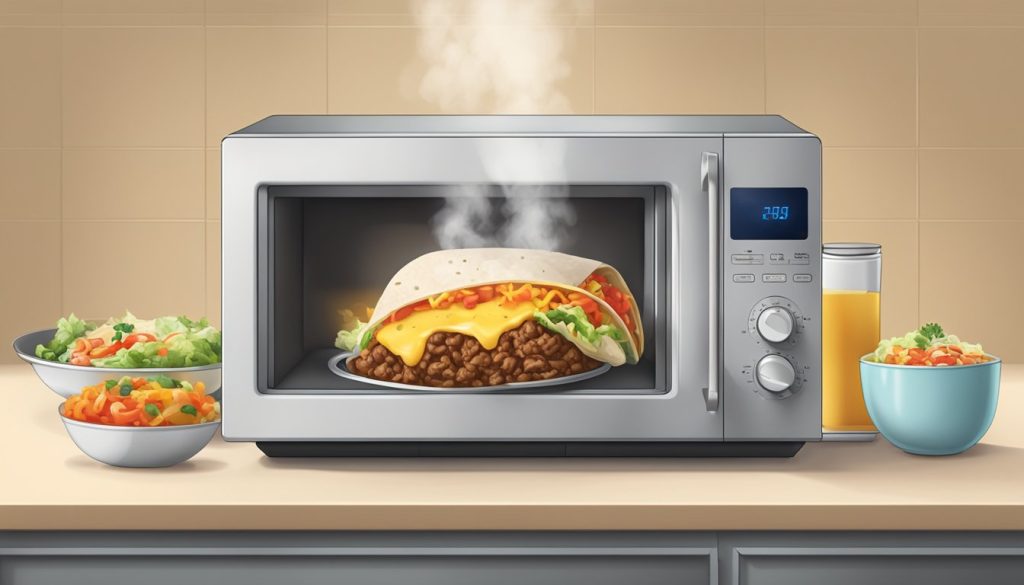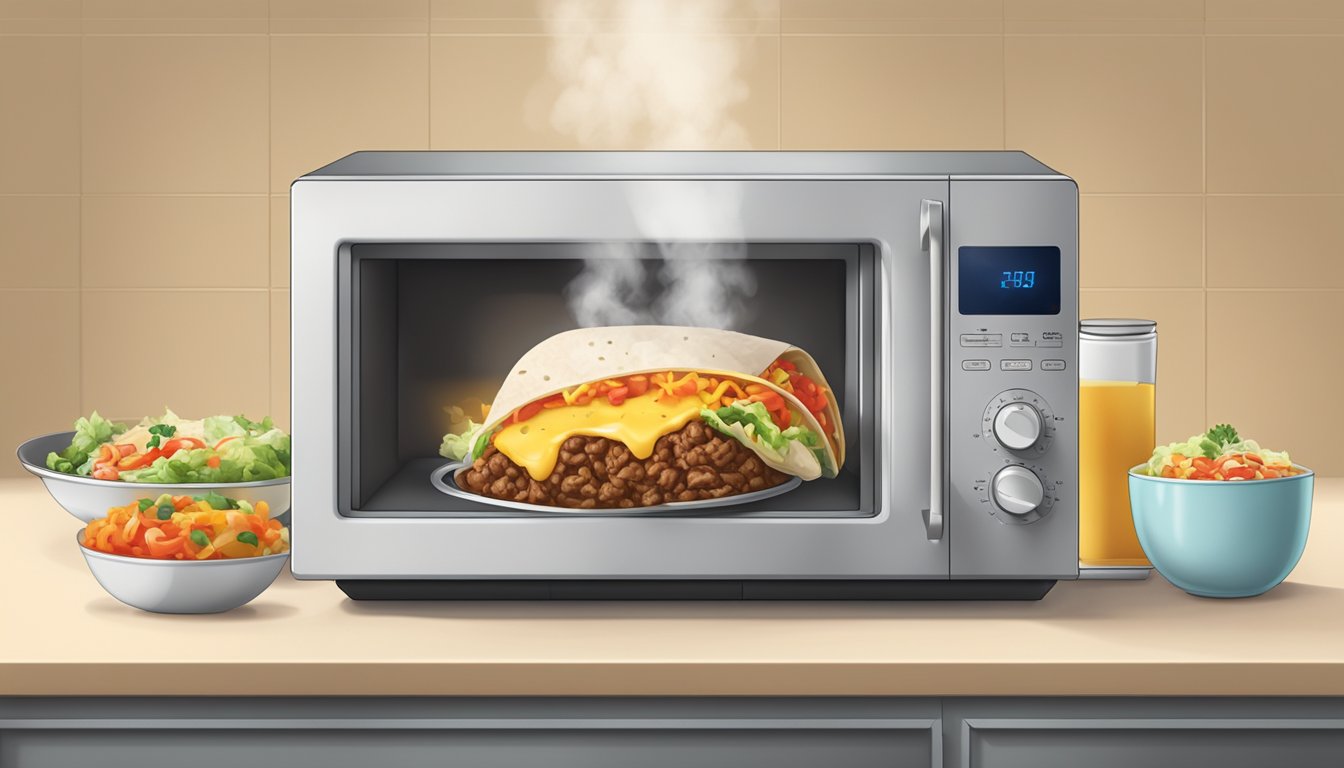Leftover beef burrito bowls can be a delicious meal, but reheating them properly is crucial to maintain their flavor and texture. Many people struggle with this task, often ending up with soggy tortillas or dried-out meat. The best method to reheat a beef burrito bowl is in the oven at 350°F (175°C) for about 15 minutes, with the components separated and covered with foil.

Reheating beef burrito bowls requires attention to detail. Each component – the rice, beans, meat, and toppings – needs special consideration to ensure optimal results. By taking a few extra steps, it’s possible to revive the dish to near-original quality.
Proper reheating techniques can make a significant difference in the enjoyment of leftover burrito bowls. With the right approach, one can savor the flavors and textures as if the dish was freshly made. This guide will explore various methods and tips to achieve the best results when reheating beef burrito bowls.
Understanding the Basics of Reheating
Reheating beef burrito bowls requires careful attention to temperature and technique. Proper reheating ensures food safety while preserving flavor and texture.
Importance of Even Heating
Even heat distribution is crucial for reheating burrito bowls. Uneven heating can result in cold spots or overcooked areas, compromising taste and texture.
To achieve uniform heating:
- Stir the contents of the bowl periodically
- Use an appropriate heat setting on your microwave or stovetop
- Cover the bowl to trap steam and promote even cooking
For optimal results, aim for a temperature between 165°F and 180°F throughout the dish. This range ensures thorough reheating without drying out the ingredients.
Reheating and Food Safety
Proper reheating is essential for food safety. Beef and other meats must reach an internal temperature of 165°F to kill harmful bacteria.
Use a food thermometer to check the temperature in several spots. Pay special attention to the center of the bowl, as it may heat more slowly.
Avoid leaving reheated food at room temperature for extended periods. Consume within 2 hours of reheating to minimize bacterial growth.
If reheating in batches, keep the remaining portions refrigerated until ready to heat. This practice helps maintain food quality and reduces safety risks.
Preparing Your Beef Burrito Bowl for Reheating
Proper preparation is key to maintaining the flavor and texture of your leftover beef burrito bowl. Separating components and handling toppings correctly ensures optimal results when reheating.
Separation of Components
Remove cold toppings like fresh pico de gallo, sour cream, and cheese from the burrito bowl. Store these separately in airtight containers in the refrigerator. This prevents wilting or melting during reheating.
Divide rice and beans from the meat if possible. These items reheat at different rates, so separating them allows for more even warming.
If guacamole is present, scoop it out and store separately to avoid browning.
For items like lettuce or other leafy greens, remove and set aside. These are best added fresh after reheating.
Preparation of Toppings and Add-ons
Drain excess liquid from salsa or pico de gallo to prevent sogginess. Pat dry with a paper towel if needed.
Allow cold toppings like sour cream and cheese to come to room temperature while reheating the main components. This helps prevent temperature shock when reassembling.
Slice fresh ingredients like tomatoes or avocados just before serving to maintain their texture and flavor.
If tortilla chips are included, store them in a sealed bag to retain crispness. These can be briefly warmed in the oven separately.
For any sauce packets, check if they’re microwave-safe before reheating with the bowl.
Reheating Methods
Properly reheating beef burrito bowls preserves their flavor and texture. Several effective techniques can be used to warm up leftover burrito bowls.
Oven Reheating Technique
Oven reheating provides even heating and helps maintain the bowl’s texture. Preheat the oven to 350°F (175°C). Transfer the burrito bowl contents to an oven-safe dish. Cover with aluminum foil to prevent drying.
Heat for 15-20 minutes, stirring halfway through. For crispier toppings, remove the foil for the last 5 minutes. Use oven mitts when handling hot dishes.
A toaster oven works well for smaller portions, following the same temperature and time guidelines.
Microwave Reheating Steps
Microwave reheating is quick but requires careful attention to prevent uneven heating. Place the burrito bowl in a microwave-safe dish. Cover with a microwave-safe lid or wrap to trap moisture.
Heat on medium power for 1-2 minutes. Stir the contents and rotate the dish. Continue heating in 30-second intervals until thoroughly warm.
Let the bowl stand for 1 minute before serving to allow heat to distribute evenly.
Air Fryer Reheating Process
Air fryers offer a balance of speed and texture preservation. Preheat the air fryer to 350°F (175°C). Place the burrito bowl contents in the air fryer basket, avoiding overcrowding.
Cook for 3-4 minutes, shaking the basket halfway through. For larger portions, work in batches to ensure even heating.
The air fryer method is particularly effective for crisping up any tortilla strips or other crunchy toppings.
Alternative Heating Methods
A skillet on the stovetop provides another reheating option. Heat a non-stick pan over medium heat. Add the burrito bowl contents and stir frequently for 5-7 minutes until warmed through.
For outdoor events, a portable grill can reheat burrito bowls. Place the contents in a foil packet and heat for 10-12 minutes, turning occasionally.
Steam reheating works well for rice-heavy bowls. Use a steamer basket over simmering water for 5-7 minutes.
Additional Reheating Considerations
Reheating beef burrito bowls requires careful attention to maintain optimal flavor and texture. Proper techniques can address common issues like sogginess and ensure the best results, even when starting with frozen burritos.
Adjustments for Frozen Burritos
Frozen burritos need special handling to reheat properly. Start by thawing them in the refrigerator overnight. If time is limited, use the microwave’s defrost function for 1-2 minutes. Once thawed, wrap the burrito in a damp paper towel before microwaving on high for 1-2 minutes.
For oven reheating, preheat to 375°F (190°C). Wrap the frozen burrito in foil and bake for 40-45 minutes. Remove the foil for the last 5-10 minutes to crisp the tortilla.
Adjust cooking times based on the burrito’s size and filling. A meat thermometer can ensure the internal temperature reaches 165°F (74°C) for food safety.
Preventing a Soggy Burrito
To avoid a soggy burrito, separate wet and dry ingredients before reheating. Remove cold toppings like sour cream, guacamole, and lettuce. Store these separately and add them after reheating.
Use paper towels to absorb excess moisture from the filling. This step is crucial for maintaining the burrito’s texture.
When microwaving, place the burrito on a microwave-safe plate lined with paper towels. Heat in 30-second intervals, rotating the burrito each time for even warming.
For oven reheating, use a wire rack placed on a baking sheet. This allows air circulation, preventing sogginess on the bottom of the burrito.
Achieving a Crispy Tortilla
A crispy tortilla can elevate the reheated burrito experience. For stovetop reheating, heat a non-stick skillet over medium heat. Place the burrito seam-side down and cook for 2-3 minutes per side until golden brown.
In the oven, brush the tortilla lightly with oil before wrapping in foil. During the last few minutes of heating, unwrap the burrito and place it directly on the oven rack to crisp.
For added crunch, try using a panini press or George Foreman grill. These methods provide even pressure and heat, resulting in a perfectly crispy exterior.
Remember to monitor the burrito closely to prevent burning. The goal is a crisp tortilla while maintaining a warm, moist filling.
Finishing Touches and Serving

The final steps in reheating your beef burrito bowl can elevate it from a simple reheated meal to a restaurant-quality dish. Adding fresh toppings and choosing appropriate accompaniments enhances both flavor and presentation.
Garnishing and Adding Fresh Toppings
Fresh toppings bring new life to reheated burrito bowls. Sprinkle shredded cheese on top immediately after reheating to allow it to melt slightly. Add a dollop of sour cream for creamy richness. Chopped cilantro provides a burst of fresh flavor and color.
Pico de gallo is an excellent addition, offering acidity and crunch. Prepare it by mixing diced tomatoes, onions, jalapeños, and cilantro with lime juice and salt. Sliced avocado or guacamole contributes healthy fats and a smooth texture.
For extra heat, drizzle hot sauce or add pickled jalapeños. A squeeze of fresh lime juice brightens the entire dish.
Serving Suggestions
Serve the reheated beef burrito bowl in a wide, shallow dish to showcase all components. Arrange toppings in sections for visual appeal. Provide warm tortillas on the side for those who wish to create their own burritos.
Offer a variety of salsas, from mild to spicy, to cater to different preferences. Include a small side salad with mixed greens and a light vinaigrette for added freshness.
For drinks, consider serving Mexican-style beverages like horchata or agua fresca. A cold cerveza or margarita can complement the meal for those who enjoy alcoholic options.
Ensuring Quality and Enjoyment

Proper reheating techniques and temperature monitoring are crucial for maintaining the quality and flavor of beef burrito bowls. These methods ensure food safety while preserving the texture and taste of each component.
Monitoring Optimal Internal Temperature
Achieving the correct internal temperature is essential for both safety and flavor. Use a food thermometer to check that the center of the beef reaches at least 74°C (165°F). This temperature kills harmful bacteria while keeping the meat juicy.
Insert the thermometer into the thickest part of the beef. Avoid touching the container or other ingredients. If the temperature is too low, continue heating in short intervals. For even heating, stir the contents gently halfway through reheating.
Reheating Tips for the Best Experience
To preserve texture, reheat components separately when possible. This prevents overcooking and maintains the individual flavors. Heat rice and beans first, then add warmed meat and toppings.
Cover the bowl with a damp paper towel when microwaving. This creates steam and prevents drying. For oven reheating, use foil to trap moisture. Avoid overheating, as this can make ingredients rubbery or dry.
Add fresh toppings like lettuce, salsa, or guacamole after reheating. This maintains their crisp texture and bright flavors. A splash of lime juice can refresh the overall taste of the reheated burrito bowl.
